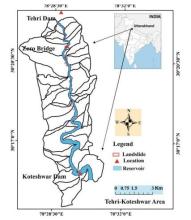Surface Displacement Analysis of Road-Cut Slopes in the Vicinity of Koteshwar Area, Uttarakhand, India
| Abstract | It is essential to assess the gradual slope deformations which can be used to interpret the temporal changes in any mountainous terrain provided the magnitude and orientation of the downward displacements are known. In this study, the slope surface displacements of two vulnerable and high-priority slopes at 12.55 km and 13.85 km from a reference point called Zero bridge along the Tehri-Koteshwar transportation route in the vicinity of Koteshwar area, Uttarakhand, India, were analysed. The study was carried out using orthorectified linear imaging self-scanning (LISS IV) optical remote sensing data from the year 2012–2017 for estimating the surface displacements based on the pixel shift with the help of COSI-CORR (co-registration of optically sensed images and correlation) tool in ENVI (Exelis visual information solutions) platform. The slopes considered in this study were mapped on the field and were demarcated on the high-resolution optical imageries, i.e. LISS IV mx (5.8 m resolution). Initially, the various optical images (slave images) ranging from the year 2012–2017 were co-registered using a master image (geo-referenced). These co-registered imageries were run for correlation using five sets of image pair (i.e. the year 2012–2013, 2013–2014, 2014–2015, 2015–2016 and 2016–2017) which reflected the pixel shifts in the images with respect to the each other. The pixel shifts in all the image pairs were modelled using ERDAS imagine software to calculate the slope surface displacements, and a similar model was run for all the image pairs. This resulted in various values of slope surface displacements over the time period of five years. The resultant displacement rasters were then analysed for displacement vector fields which indicated the direction (bearing) of material movements. The average pixel shift trends for various image pairs have indicated that the slope surface displacements increased between the year 2012–2015 whereas, after 2015, the correlation indicated a decrease in the surface displacements at the study sites. This study has highlighted the use of optical remote sensing data in analyzing the gradual slope movements and their orientation. Such a study can be utilized to estimate slope deformation annually. This may help researchers/stakeholders to understand the planning/managing mitigation measures on the required locations of vulnerable slopes. |
| Faculty |
Dr. Har Amrit Singh Sandhu
|
|
hassandhu@pec.edu.in
|
|
| Collaborations | Dr. Swati Sharma, Dr. Manoj Kumar Arora |
| More Information | DOI: https://doi.org/10.1007/978-3-030-76116-5_5 |







